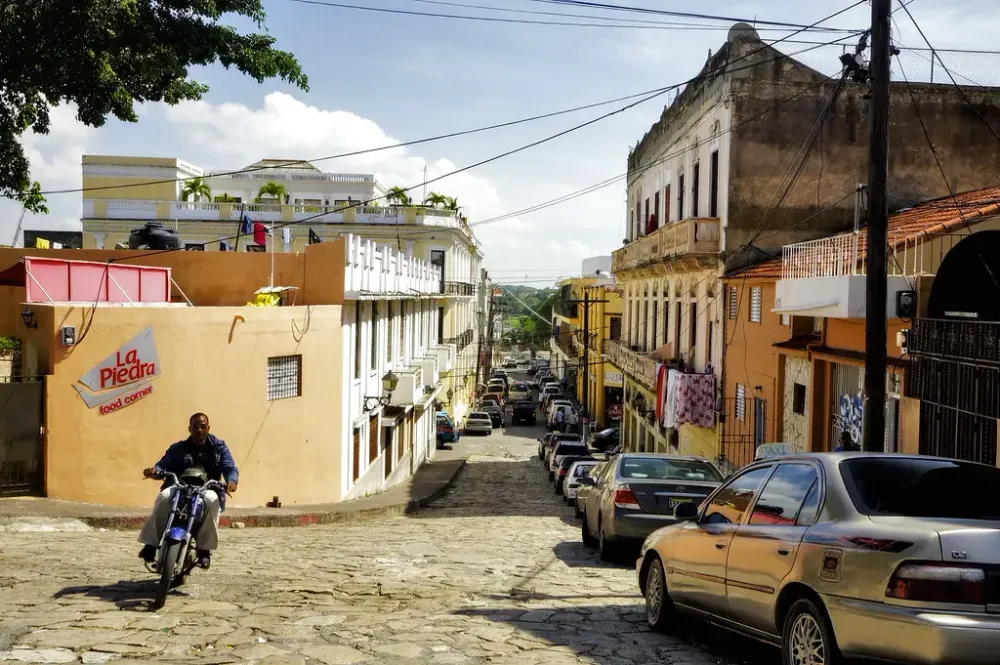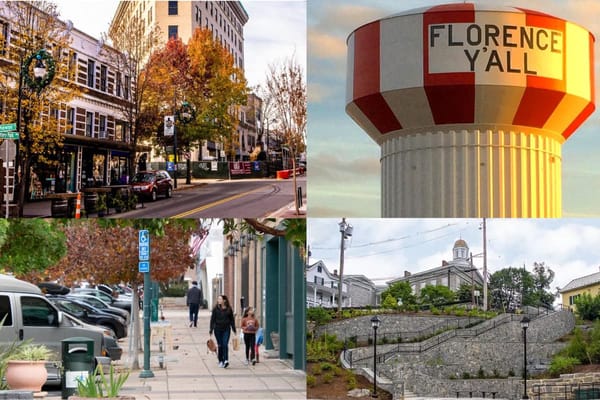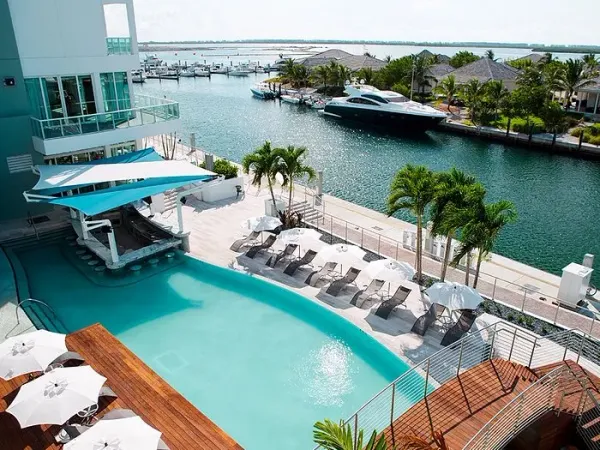17 Best Things To Do In Santo Domingo For An Unforgettable Trip
Santo Domingo is a living history book. Founded in 1496 by Bartholomew Columbus, brother of Christopher Columbus, it holds the title of the oldest continuously inhabited European settlement in the Americas. The Colonial Zone, declared a UNESCO World Heritage Site, is where the New World truly began. Here, the first cathedral, fortress, hospital, and paved street of the Americas were built, turning Santo Domingo into Spain’s launchpad for exploration across the continent.
But Santo Domingo isn’t only about the past. Today, it’s a bustling mix of historic charm and modern energy. You’ll find museums filled with treasures from the 1500s, alongside shopping malls, vibrant markets, and a lively seaside promenade. It’s a city where every corner tells a story, yet the rhythm of merengue and bachata keeps everything joyfully in the present.
The best time to visit Santo Domingo is between December and April, when the weather is dry, sunny, and pleasantly warm. These months are perfect for walking the Colonial Zone without breaking a sweat, enjoying beach days along the Malecón, or exploring outdoor attractions like Los Tres Ojos.
Let's explore the 17 best things to do in Santo Domingo to make your trip unforgettable.
1. Columbus Park (Parque Colón)
Important Information
- Address: Calle Isabel La Católica, Colonial Zone, Santo Domingo, Dominican Republic.
- Contact Details: Public square—no official contact
- Pricing / Admission Fee: Free and open 24/7
- Nearby Accommodation: Centrally located in the Colonial Zone—walking distance to boutique hotels and B&Bs
- Accessibility: Public square, flat and accessible to all visitors
- Opening & Closing Times: Always open to the public
- Parking: Limited street or nearby paid parking—best explored on foot
- Accessibility (ADA): Open, flat plaza—accessible
- Distance to City Center: At the heart of the historic city center
- Special Note: A lively gathering hub known for historic monuments, street performers, events, and romantic proposals
If Santo Domingo had a beating heart, it would be Columbus Park, also called Parque Colón. This lively square is where past and present come together in the most Dominican way possible. At its center stands a bronze statue of Christopher Columbus, pointing toward the “New World.” The monument was placed here in 1887, but the real magic is in the surroundings. The square is bordered by some of the most important colonial buildings in the Americas, including the first cathedral of the New World, the Archbishop’s Palace, and historic homes of Spanish governors.
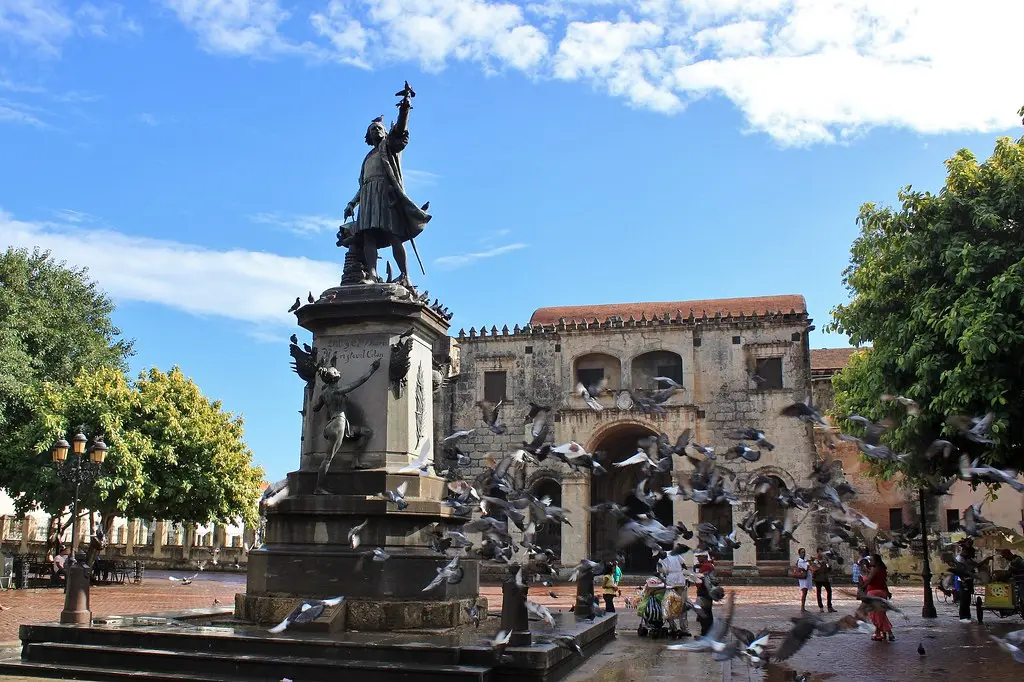
In the 16th century, this plaza was the city’s gathering point for announcements, ceremonies, and even celebrations after voyages. Today, it’s still the favorite meeting spot for both locals and travelers. You’ll find shoe shiners working under the shade of old trees, kids chasing pigeons, and street artists filling the air with music and laughter. Cafés with outdoor seating spill into the square, making it the perfect place to sip a coffee or cold Presidente beer while watching the rhythm of the city. Standing here, you’re not just in a park—you’re standing where history started for the Americas.
2. Cathedral of Santa María la Menor (Nuestra Señora de la Encarnación)
Important Information
- Address: Between Calle Arzobispo Meriño and Isabel La Católica, next to Columbus Park
- Contact Details: Not commonly listed publicly
- Pricing / Admission Fee: Free admission
- Nearby Accommodation: Steps from Colonial Zone lodging
- Accessibility: Historic site; flat entry—confirm specific needs with staff
- Opening & Closing Times: Monday–Saturday, 9:00 AM–4:30 PM
- Parking: Street or nearby paid options—car-free exploration recommended
- Accessibility (ADA): Basic access—enquiries recommended for detailed assistance
- Distance to City Center: At the colonial core, adjacent to Parque Colón
- Notable Info: The oldest cathedral in the Americas (begun 1504, completed 1550), Gothic architecture, UNESCO World Heritage site
Just a few steps from Columbus Park rises one of the greatest treasures of the New World: the Cathedral of Santa María la Menor, also known as Catedral Primada de América. Finished in 1540, it holds the title of the oldest cathedral in the Americas. Its construction reflects the wealth and ambition of Spain during the Age of Exploration, blending late Gothic, Baroque, and Renaissance elements. Built from golden coral limestone, the cathedral shines warmly under the Caribbean sun.
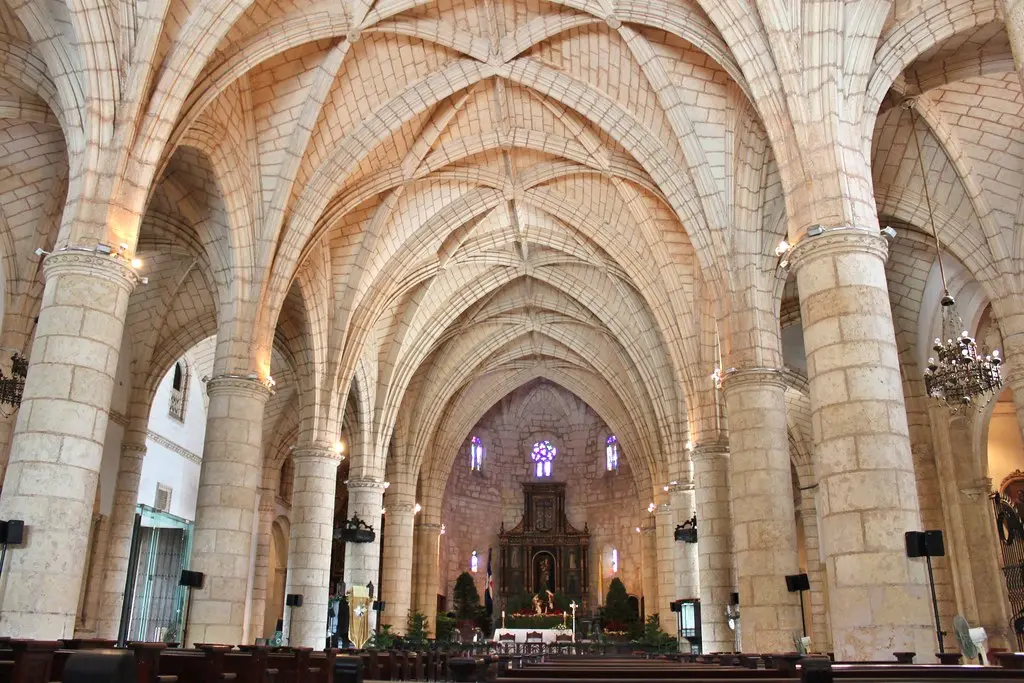
Step inside, and you’ll find high vaulted ceilings, ornate chapels, and wooden doors that have survived for nearly five centuries. The cathedral was once a safe house for treasures brought from the colonies, and it has seen everything from pirate attacks to revolutions. For years, many believed that Christopher Columbus’s remains rested here before they were moved to the Columbus Lighthouse. Whether true or not, the legend only adds to the cathedral’s mystique.
Today, it’s not only a place of worship but also a museum of faith, history, and art. Walking through its echoing halls feels like stepping into a time capsule of the 1500s, a reminder of when Santo Domingo was the first jewel of Spain’s American empire.
3. Museum of the Royal Houses (Museo de las Casas Reales)
Important Information
- Address: Calle Las Damas, corner with Calle Las Mercedes, south of Plaza de España, Colonial Zone, Santo Domingo
- Contact Details: Part of National Museums system; details available at cultura.gov.do
- Pricing / Admission Fee: Not specified in sources — usually moderate or free
- Nearby Accommodation: In prime historic district—close to central lodging
- Accessibility: Accessible museum setting within historic building
- Opening & Closing Times: Standard museum hours apply—please confirm locally
- Parking: Limited; best reached by walking from other Colonial Zone sites
- Accessibility (ADA): Areas accessible—check for lifted or ramped sections
- Distance to City Center: Within historic core
- Highlights: Once housed Spanish colonial government and judiciary; features original 16th-century architecture and galleries showcasing maps, weapons, daily life, masterpieces like the only known shield of Queen Joanna I
Step back in time at the Museum of the Royal Houses, one of Santo Domingo’s most important historic gems. Built in the early 1500s, this elegant complex originally served as the administrative center of the Spanish colonies in the Americas. Here, the governor’s palace and treasury once operated, making it the beating heart of Spanish authority in the New World.
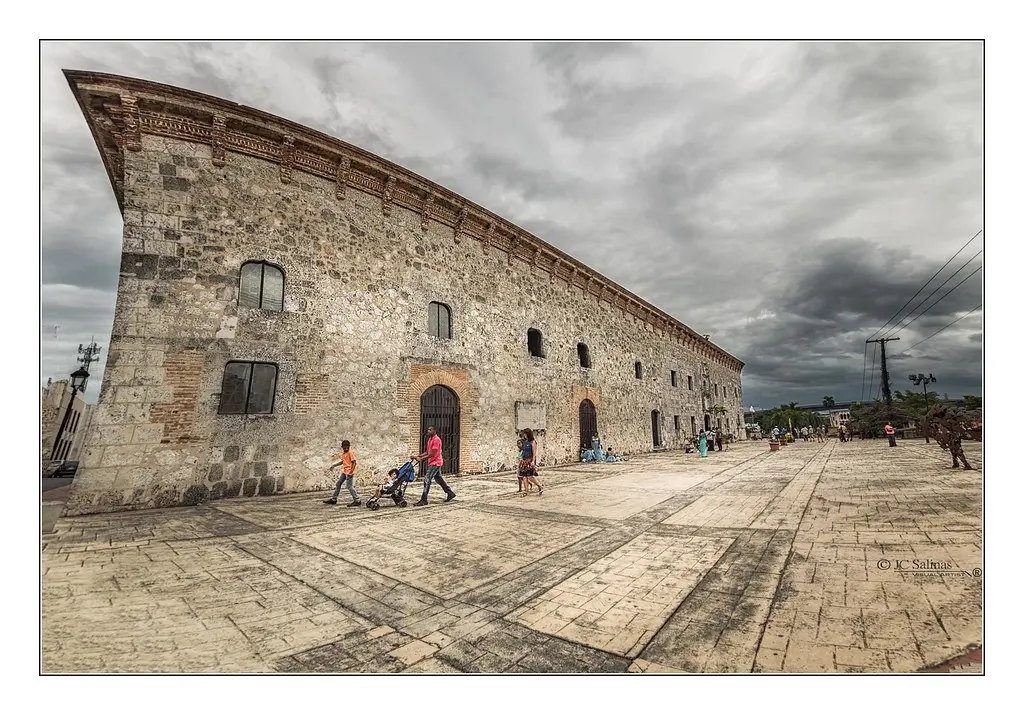
Inside, you’ll find exhibits that trace the Dominican Republic’s colonial past, from the arrival of Columbus to the rise of independence movements. Rooms display antique maps, weapons, furniture, and even pieces of everyday life from centuries ago. Walking through the stone corridors, you can almost hear the echoes of officials making decisions that shaped the future of the Americas.
The museum isn’t only about politics, though. It also celebrates Dominican culture with displays of Taíno artifacts, African influences, and European traditions blending together. The building itself is part of the attraction, with its thick coral-stone walls and beautiful courtyards offering a cool escape from the Caribbean sun. Whether you’re a history buff or just curious, this museum lets you connect with the stories that gave Santo Domingo its place as the very first capital of Spain’s empire in the New World.
4. National Botanical Garden Dr. Rafael María Moscoso
Important Information
- Address: Avenida República de Colombia, sector Los Próceres (Altos de Galá), Santo Domingo
- Contact Details: Tel: (809) 385‑2611 ext. 221; Email: jardinbotanico@jbn.gob.do
- Pricing / Admission Fee: Not specified; typical state garden fee likely applicable
- Nearby Accommodation: Located outside the historic core; best visited via private vehicle or taxi
- Accessibility: Paved paths, garden trains, and facilities serve varied abilities
- Opening & Closing Times: Not listed—check official site before visiting
- Parking: Onsite parking available
- Accessibility (ADA): Paths and attractions designed for easy access
- Distance to City Center: Moderate distance—approx. 10–15 minutes’ drive
- Highlights: The largest botanical garden in the Caribbean, spanning 400 acres, including themed gardens, rock formations, train ride, Japanese garden, and nature trails
Need a break from stone walls and history lessons? The National Botanical Garden is Santo Domingo’s green sanctuary. Spanning over 400 acres, it’s the largest botanical garden in the Caribbean and was named after Rafael María Moscoso, the first Dominican botanist to catalog the country’s plants. Opened in 1976, it’s a living museum of tropical biodiversity.
Visitors can hop on a small train that loops around the gardens, making it easy to explore without breaking a sweat. Along the way, you’ll discover themed areas like the Japanese Garden, cactus zones, and orchid collections bursting with color. Towering palm trees, winding trails, and a symphony of bird calls make it feel worlds away from the bustling city.
5. Sambil Santo Domingo
Important Information
- Address: John F. Kennedy Avenue, intersection of metro lines in Santo Domingo
- Contact Details: Phone: (809) 234‑5678; Email: info@sambil.com.do; Mall hours: Mon–Fri 10 AM–9 PM; Sun & holidays 11 AM–8 PM
- Pricing / Admission Fee: Free to enter; retail, cinema, and dining costs vary
- Nearby Accommodation: Convenient access via metro and near mid‑city hotels
- Accessibility: Modern mall layout with wide aisles and elevators—generally accessible
- Opening & Closing Times: As above (Mon–Fri 10 AM–9 PM; Sun 11 AM–8 PM)
- Parking: Ample onsite parking available
- Accessibility (ADA): Fully accessible facilities are expected in modern malls
- Distance to City Center: Approximately 10–15-minute drive from Colonial Zone
- Notable Info: Popular large shopping center offering a mix of international and local brands, dining, cinema, entertainment—named one of the most fun malls in the country
If shopping is your kind of adventure, Sambil Santo Domingo is the city’s ultimate retail playground. Opened in 2012, this massive shopping mall is more than just a place to buy clothes—it’s a full entertainment hub that locals and visitors alike flock to. With hundreds of stores, from international fashion brands to Dominican boutiques, it’s easy to spend hours wandering through the sleek corridors.
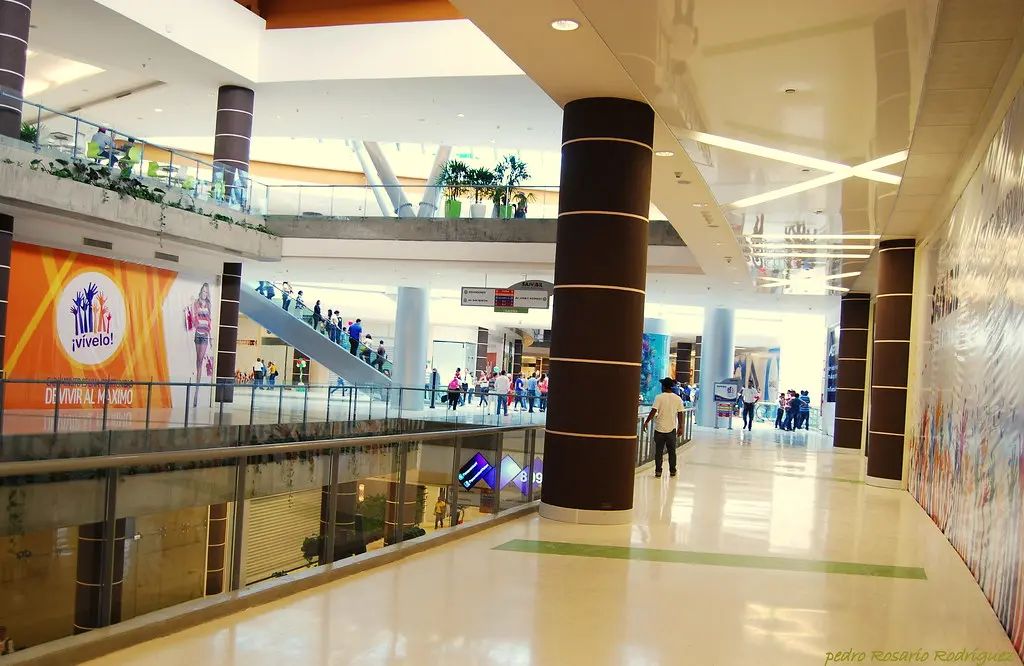
The mall also features a wide range of dining options, from quick bites and local favorites to international chains. Families love it because there’s always something going on—arcades, a large cinema complex, seasonal exhibitions, and even themed events that transform the mall into a mini festival ground.
Historically, malls like Sambil marked a shift in Dominican urban culture, turning shopping into an all-day social experience rather than just an errand. It’s where friends gather, teenagers hang out, and families spend Sundays together. For travelers, it’s a perfect spot to cool off in air-conditioning, grab a meal, catch a movie, and maybe pick up some souvenirs.
6. Fortaleza Ozama
Important Information
- Address: At the end of Calle Las Damas, Colonial Zone, Santo Domingo, Dominican Republic
- Contact Details: General info: 809‑686‑0222 (Lonely Planet)
- Pricing / Admission Fee: Details vary—booking platforms available, but no fixed public fee readily found
- Nearby Accommodation: Centrally placed in the Colonial Zone, within easy walking distance of historic hotels and B&Bs.
- Accessibility: Historic fortress with cobbled paths; contact ahead for specific ADA support.
- Opening & Closing Times: Typically open Tuesday through Saturday, 9:00 AM–5:00 PM; Thursdays and Sundays often closed
- Parking: Limited nearby parking; best explored on foot from the city center.
- ADA Compliance: Limited information—access likely restricted by stairs and uneven surfaces.
- Distance to City Center: Located right within the historic heart of the Colonial Zone.
- Highlights: Presumed to be the oldest military construction by Europeans in the Americas; features medieval-style towers, dungeons, and sweeping views of the Ozama River
Standing guard over the Ozama River since 1502, Fortaleza Ozama is the oldest surviving European fortress in the Americas. Built by the Spanish to protect their new colony, it was a symbol of power during the early days of Santo Domingo. For centuries, it kept watch over incoming ships and defended the city against pirates and rival nations.
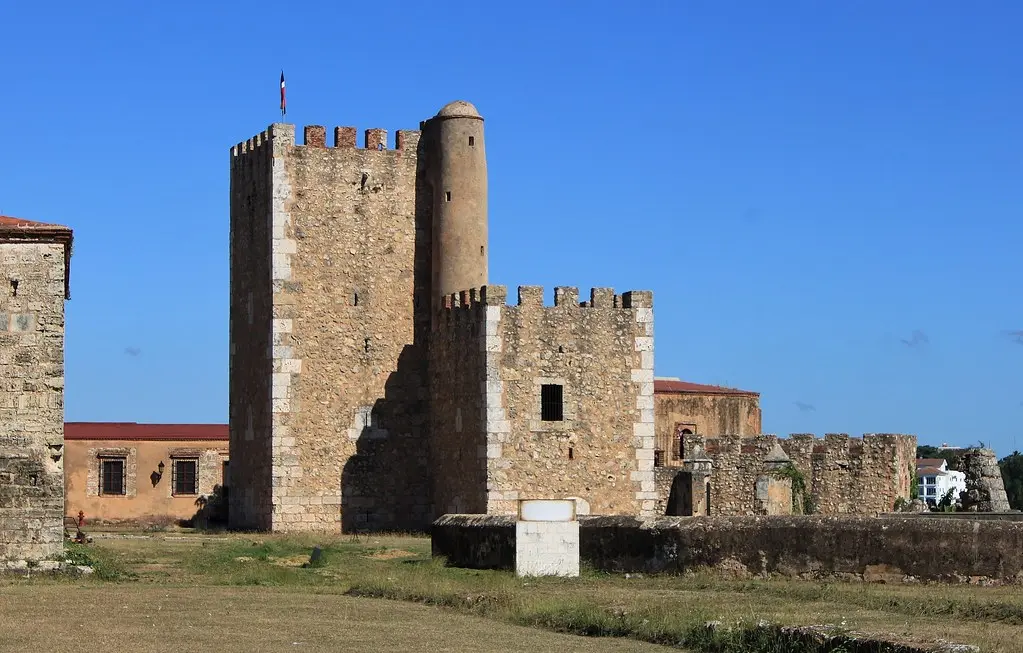
The fortress, made of coral stone, is crowned by the imposing Torre del Homenaje (Tower of Homage), a sturdy keep that once served as both a lookout and a prison. Many stories linger in its thick walls—tales of Spanish governors, imprisoned revolutionaries, and even legends of hidden treasures. Climbing to the top offers sweeping views of the river and the Colonial Zone, a reminder of why this location was so strategically important.
During its long history, Fortaleza Ozama was used not only for defense but also as a military prison well into the 20th century. Today, it’s a UNESCO World Heritage Site and a must-see for history lovers. Walking through its stone passages feels like stepping straight into a pirate movie set, except this one is real. It’s a place where history, legend, and the salty Caribbean breeze all come together.
7. Plaza de la Hispanidad (Plaza de España)
Important Information
- Address: Calle La Atarazana 2, Ciudad Colonial, Santo Domingo
- Contact Details: General operator: Santo Domingo City Council (no direct public contact provided)
- Pricing / Admission Fee: Free public space
- Nearby Accommodation: Surrounded by hotels, cafés, and restaurants—ideal central location.
- Accessibility: Open flat plaza—wheelchair friendly and pedestrian-accessible.
- Opening & Closing Times: Generally open—specific hours not formalized due to open-air nature; adjacent sites operate typical daytime hours.
- Parking: Limited street parking; best accessed on foot from nearby Colonial Zone lodging.
- Notable Features: Flanked by the Alcázar de Colón and the Museum of the Royal Houses; hosts festivals, events, and features a statue of Nicolás de Ovando
Overlooking the Ozama River, Plaza de la Hispanidad, also known as Plaza de España, is one of the Colonial Zone’s grandest open spaces. Built in the late 20th century to celebrate the city’s 500th anniversary, it blends old-world charm with modern flair. At its center stands the impressive statue of Nicolás de Ovando, the Spanish governor who oversaw much of the city’s early construction. But the real stars are the historic buildings framing the square—most famously the Alcázar de Colón, the palace built by Christopher Columbus’s son, Diego.

Back in colonial times, this area was buzzing with trade, politics, and society gatherings. Ships unloaded goods nearby, and nobles strolled across the square in ornate costumes. Today, the vibe is just as lively but in a different way. Restaurants and cafés line the plaza, with outdoor tables perfect for sipping wine under the stars. It’s also the stage for concerts, festivals, and cultural events that keep Santo Domingo’s history alive through music and dance.
8. Kahkow Experience
Important Information
- Address: Calle Las Damas 102, Ciudad Colonial, Santo Domingo.
- Contact Details: Contact via their site or email; daily open from around 10 AM to 8 PM.
- Experience & Pricing: A unique, family-friendly guided chocolate tour showcasing the Dominican cacao process — learn, taste, and engage with interactive multimedia exhibits. Often includes tastings and even lunch.
- Nearby Accommodation: Centrally located in the Colonial Zone — walking distance from historic hotels and guesthouses.
- Accessibility: Museum-style setting with multimedia presentations — inquire ahead for specific ADA accommodations.
- Opening & Closing Times: Open daily; likely daytime hours; confirm timings with operator or booking site.
- Parking: Minimal in the narrow Colonial streets — best reached on foot or via short taxi ride.
- Proximity to City Center: Located within the heart of the Colonial Zone — easy to pair with cultural walking routes.
Calling all chocolate lovers—this one’s for you! The Kahkow Experience is an interactive museum that celebrates one of the Dominican Republic’s sweetest treasures: cacao. The country is one of the world’s leading producers of fine cacao, and this attraction takes you straight from bean to bar.
Inside, you’ll journey through the history of cacao in the Dominican Republic, learning how this humble bean traveled from ancient civilizations to become the global delight we know today. Exhibits show traditional farming techniques, the process of fermentation and roasting, and the artistry behind making gourmet chocolate. One of the highlights is the hands-on workshop, where you can actually craft your own chocolate bar—personalized with toppings of your choice.
9. Santo Domingo Malecón
Important Information
- Address: A long oceanfront boulevard officially known as Avenida George Washington, running along the Caribbean shoreline.
- Features: A vibrant cultural artery — perfect for walking, jogging, biking, and taking in flowing art and history. Key landmarks include the Obelisco Macho and Obelisco Hembra, Plaza Juan Barón, and numerous sculptures and street food stands.
- Nearby Amenities: Lined with hotels, restaurants, bars, and entertainment venues — great as both a leisure spot and nightlife hub.
- Accessibility: Recently revitalized with pedestrian zones, cycling paths, benches, and improved lighting — very accessible.
- Opening & Closing Times: A public open-space with no formal hours — best enjoyed at sunset into the evening when local life blooms.
- Special Note: Offers stunning views, a lively atmosphere, and one of the best ways to feel the city's pulse.
Few places capture Santo Domingo’s spirit like the Malecón, a long seaside boulevard that hugs the Caribbean coast. Stretching for miles, it’s where locals and visitors alike come to stroll, drive, or simply soak in the ocean breeze. By day, the Malecón is lined with palm trees, hotels, and cafés, offering stunning views of waves crashing against the rocky shore. By night, it transforms into one of the city’s most vibrant social hubs, buzzing with music, food stalls, and nightlife.
Historically, the Malecón was developed in the early 20th century as a showcase of the city’s modern side, contrasting the colonial charm of the old town. It has hosted parades, political rallies, and even the famous Dominican Carnival, where floats and dancers bring the avenue alive with color and rhythm. For many Dominicans, the Malecón is tied to memories of celebrations, romance, and Sunday family outings.
10. Ágora Mall
Important Information
- Address: At the intersection of Avenida John F. Kennedy and Avenida Abraham Lincoln, Santo Domingo.
- Contact Details & Hours: Typically open Monday–Saturday 10 AM–9 PM; Sunday 12 PM–8 PM. Dining options operate within similar hours.
- Features: A modern shopping and lifestyle center — home to over 180 stores, including international brands like ZARA, Gucci, and L’Occitane, plus a vibrant food court, cafes, and entertainment zones.
- Sustainability Highlights: The first LEED-certified large-scale mall in the Caribbean, integrating energy-efficient systems and eco-friendly facilities.
- Accessibility & Parking: Fully wheelchair-accessible, with expansive covered parking — including disabled spaces — for easy access.
- Proximity to City Center: About a 10–15 minute drive from the Colonial Zone — centrally located in modern Santo Domingo.
- Popularity: Highly ranked by visitors — considered a must-visit staple for locals and tourists alike.
If Sambil shows Santo Domingo’s fun, Ágora Mall reveals its stylish side. Opened in 2012, Ágora Mall quickly became one of the city’s most iconic shopping centers—not just for its variety of stores but for its eco-friendly design. Built with natural light, green spaces, and sustainable materials, it’s considered the Caribbean’s first “green” mall.
Inside, you’ll find over 180 shops ranging from international fashion brands to Dominican designers, plus plenty of restaurants, cafés, and entertainment options. Its architecture is sleek and modern, with wide open spaces that feel less like a shopping center and more like a social plaza. Families flock here for weekend outings, teenagers meet friends for movies and fast food, and professionals grab lunch in its airy food court.
Ágora Mall also goes beyond commerce—it regularly hosts cultural events, art displays, and charity initiatives, becoming a true community hub. Its rooftop garden and eco-initiatives reflect a growing awareness of sustainability in Dominican urban life.
11. The Three Eyes National Park (Los Tres Ojos)
Important Information
- Address: Avenida Las Américas, Parque Mirador del Este, Santo Domingo Este
- Contact Details: (809) 788‑7056
- Pricing: RD$50 for foreigners, RD$30 for children and students
- Opening Hours: Daily, 8:30 AM – 5:30 PM
- Nearby Accommodation: Roughly 10 minutes by car from the Colonial Zone—easy to combine with historic site visits
- Accessibility: Requires navigating 346 stairs between caves and a small boat ride to the fourth lagoon
- Parking: On-site parking available or accessible via taxi/public transit
- Distance to City Center: Approximately a 10-minute drive
- Highlights: Three limestone cave lakes—plus a fourth via raft—rich in Taino history; lush vegetation and dramatic rock formations make this a natural urban oasis
Hidden just outside Santo Domingo’s busy streets lies a natural wonder: The Three Eyes National Park, or Los Tres Ojos. This open-air limestone cave system is home to three stunning turquoise lakes, or “eyes,” formed thousands of years ago. The caves were once used by the Taíno people for rituals and as a source of fresh water. Today, they offer visitors a magical underground world that feels straight out of an adventure movie.
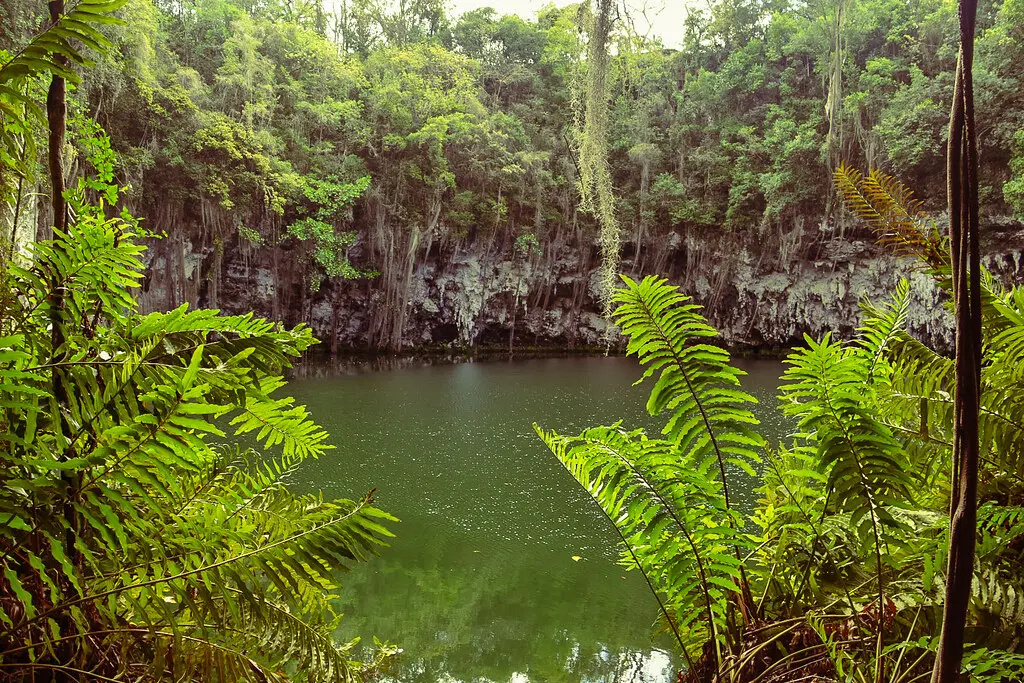
Each lake has its own character—one glows in the sunlight, another is surrounded by stalactites, and the third sits in eerie shadows. A short boat ride takes you to a hidden “fourth eye,” a breathtaking lagoon open to the sky. As you wander down stone steps into the caves, the temperature drops and the sounds of the city fade, replaced by the drip of water and the flutter of bats.
Throughout history, Los Tres Ojos has fascinated explorers and even filmmakers—it’s been featured in Hollywood movies because of its mystical beauty. For locals, it’s also a source of pride, a reminder of the island’s ancient past. Visiting here feels like discovering a secret beneath the city, where nature, history, and legend all meet.
12. Mirador del Sur Joaquín Balaguer Park
Important Information
- Description: A nearly 4-mile-long shaded urban park on a limestone ridge, with walking/jogging trails, caves, a boating pond, skate areas, and exercise zones; vehicle traffic is prohibited
- Accessibility: Ideal for walking, cycling, families, and accessible paths
- Distance to Colonial Zone: A short drive—just a few minutes south of the historic core
- Why Visit: A local favorite for relaxation, exercise, and immersive greenery within the city
When Santo Domingo residents need space to breathe, they head to Mirador del Sur Park, a massive greenbelt stretching along the city’s southern edge. Named after former president Joaquín Balaguer, who inaugurated it in the 1970s, the park was designed as both a recreational escape and a way to preserve urban nature.
Covering more than 7 kilometers, it’s one of the largest city parks in the Caribbean. Locals come here to jog, bike, rollerblade, or simply relax under towering trees. Its wide avenues and shaded trails make it a favorite for morning workouts and weekend family outings. Along the way, you’ll find playgrounds, picnic spots, and even small caves tucked into the limestone hills.
13. National Palace of the Dominican Republic
Important Information
- Address: Avenida México, Santo Domingo
- Accessibility: Grand neoclassical architecture; exterior is viewable and impressive; internal access limited—tours or guided visits required
- Opening Hours: Typically open weekdays (e.g. Monday 8:00 AM–6:30 PM); closed on weekends
- Distance to Colonial Zone: About a 20-minute walk from the heart of the Colonial Zone
- Highlights: Official seat of government, potential for witnessing changing of the guard, and a symbol of modern Dominican statehood
Shining with neoclassical elegance, the National Palace is one of Santo Domingo’s most iconic landmarks. Completed in 1947 under President Rafael Trujillo’s rule, this majestic building was designed by Italian architect Guido D’Alessandro and remains the seat of the Dominican government. Its grand white façade, broad stairways, and golden dome make it a symbol of national pride and authority.
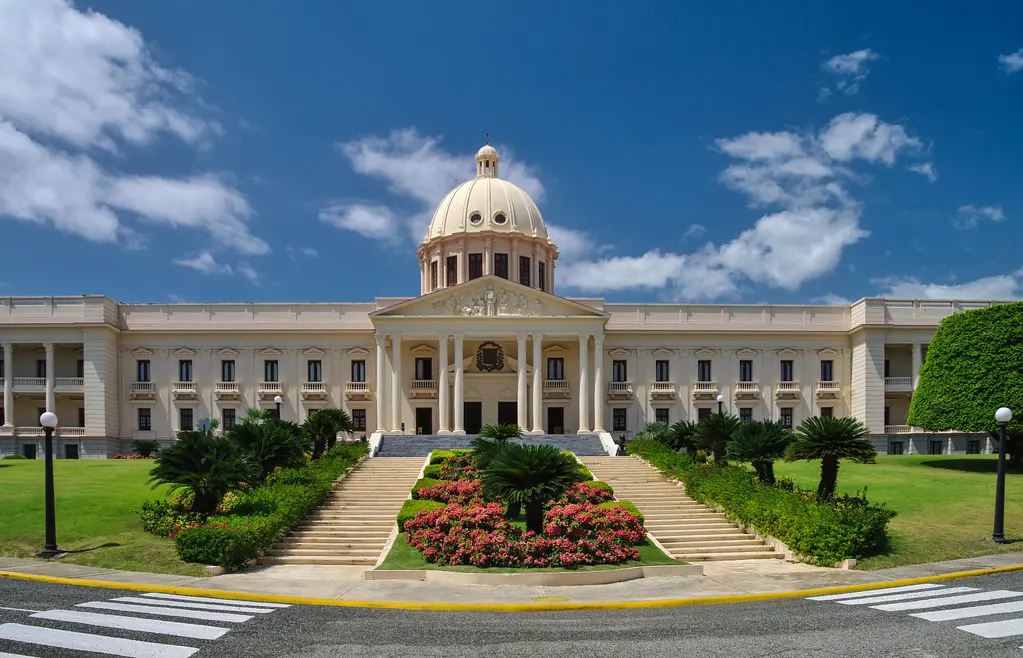
The palace isn’t just about politics—it’s also an architectural jewel. Inside, the halls are decorated with Italian marble, crystal chandeliers, and murals that tell the story of the Dominican Republic’s struggle for independence. The sprawling gardens surrounding the building are equally impressive, filled with fountains and tropical flowers that soften its stately presence.
While access to the interior is limited to official tours, even a stroll around its exterior offers plenty of photo-worthy moments. The palace has also been the backdrop for historic events, from presidential inaugurations to visits by international leaders. For Dominicans, it represents both the nation’s resilience and its aspirations.
14. Faro a Colón (Columbus Lighthouse)
Important Information
- Location: Santo Domingo Este, on the eastern bank of the Ozama River
- Description: Monument/museum shaped like a cross, functioning as a mausoleum to Christopher Columbus and housing international exhibits
- Special Feature: At night, projects cross-shaped light beams visible up to 64 km away; however, this often occurs only during special events
- Significance: Commissioned for the 500th anniversary of Columbus’s landing; serves as national monument and cultural museum
Few monuments spark as much curiosity as the Faro a Colón, or Columbus Lighthouse. Built to commemorate the 500th anniversary of Columbus’s first voyage, it was inaugurated in 1992 after decades of debate and construction. Shaped like a giant cross, this massive concrete structure stretches over 600 feet and doubles as both a mausoleum and museum.
The lighthouse is said to house some of Christopher Columbus’s remains, though the claim is disputed with Spain. Inside, you’ll find exhibits showcasing the history of the Americas, with artifacts, maps, and cultural treasures donated by countries around the world. The sheer scale of the building makes it feel more like a fortress than a lighthouse.
At night, when the lighthouse is lit, it projects a powerful beam of light shaped like a cross into the sky, visible for miles. This striking display has made it a symbol of both pride and controversy, as some view it as a grand tribute to exploration while others see it as a reminder of colonial struggles.
15. Teatro Nacional Eduardo Brito
Important Information
- Address: Plaza de la Cultura, Santo Domingo
- Contact Details & Capacity: Seats ~1,600 in Sala Carlos Piantini, plus additional Sala Ravelo (~189 seats)
- History: Opened in 1973, renamed in honor of baritone Eduardo Brito; a cornerstone of performing arts in the Dominican Republic
- Accessibility: Modern venue with likely ADA accommodations; confirm via official site
- Cultural Role: Hosts opera, ballet, classical music, Latin pop, national and international festivals; central institution in Dominican arts
If Santo Domingo had a cultural crown jewel, it would be the Teatro Nacional Eduardo Brito. Opened in 1973, this modern performing arts theater was named after Eduardo Brito, a beloved Dominican opera singer whose powerful voice made him a national icon. The theater stands proudly in the Plaza de la Cultura, surrounded by museums and art centers, making it the heartbeat of the city’s cultural scene.
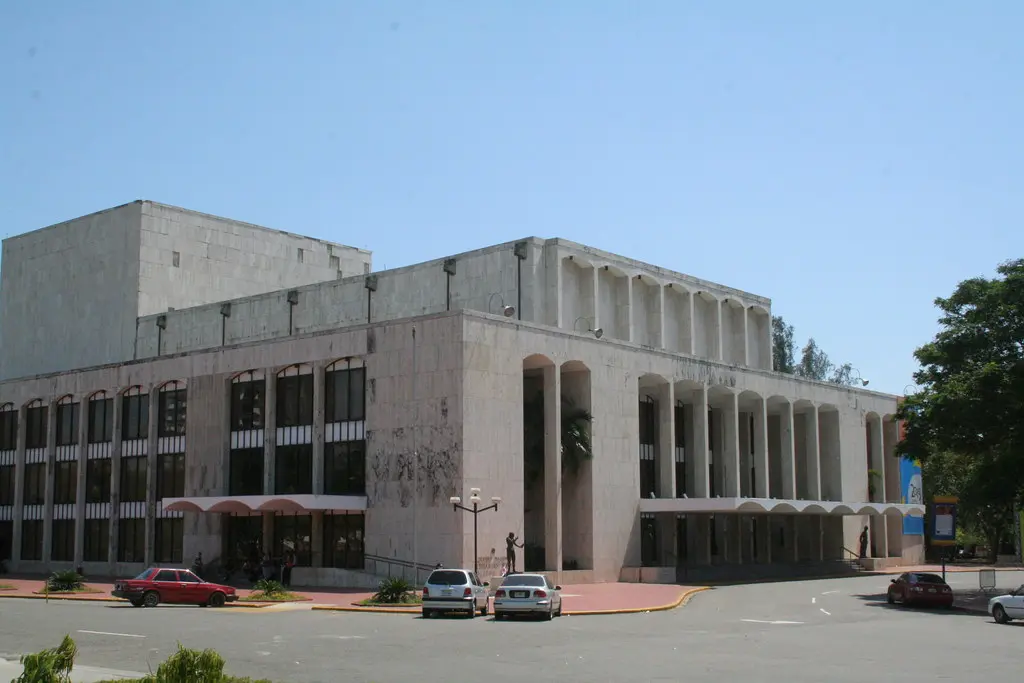
Architecturally, the building is striking, with a modernist design and grand columns that set the stage for what happens inside. The main hall, Sala Carlos Piantini, seats over 1,500 people and has hosted world-class performances—from operas and ballets to jazz concerts and Dominican folk shows. Smaller halls within the complex allow for more intimate performances, art exhibitions, and lectures.
Over the decades, the Teatro Nacional has welcomed international stars as well as local legends, making it a source of pride for Dominicans. It’s also where the country celebrates major cultural festivals, like the National Theater Festival and classical music seasons.
16. Calle Las Damas
Important Information
- Description & Location: Often cited as the first paved street in the Americas, running through the Colonial Zone
- Contact Details: Public street—no direct contact
- Admission Fee: Always open and free
- Nearby Accommodation: Fully walkable from surrounding historic hotels and inns
- Accessibility: Pedestrian-friendly cobblestone; easy to explore by foot
- Parking: Street-level or nearby Colonial Zone parking; best accessed on foot
- Highlights: Home to significant landmarks such as Fortaleza Ozama, Museo de las Casas Reales, Casa de Bastidas, and Plaza de España; rich in history, beautiful architecture, and photo ops
Walking down Calle Las Damas is like stepping back to the 1500s. Known as the oldest paved street in the Americas, it was laid out in 1502 and quickly became the promenade for Santo Domingo’s colonial elite. Its name, “Street of the Ladies,” comes from the wives of Spanish nobles who famously strolled here in the evenings, dressed in fine gowns, while soldiers and officials admired them.
The cobblestoned street is lined with some of the city’s most important colonial buildings, many of which still stand today. You’ll pass the Royal Houses, the Ozama Fortress, and elegant mansions that once belonged to Spanish governors. With its mix of history and charm, Calle Las Damas is essentially an open-air museum.
The street has seen its share of history too—from parades of conquistadors to the footsteps of explorers, governors, and revolutionaries. Today, tourists follow in those same footsteps, often with a guide retelling the street’s legends and secrets.
17. Tour the Amber World Museum
Important Information
- Address: C. Arzobispo Meriño #452 (corner of Restauración), Colonial Zone, Santo Domingo
- Contact Details: +1‑809‑682‑3309 or +1‑809‑686‑5700
- Pricing / Admission Fee:
- Free admission for most
- Some sources suggest a modest fee (approx. $2 USD / RD$100), with bilingual displays
- Opening & Closing Times:
- Monday–Saturday: 9:00 AM–6:00 PM
- Sunday: 9:00 AM–2:00 PM
- Nearby Accommodation: Centrally located in the Colonial Zone—walking distance to many hotels
- Accessibility: Small, accessible museum environment; charming shaded courtyard onsite
- Parking: Limited—best reached on foot within the Old Town
- Highlights:
- Showcases exquisite amber pieces from around the world, including specimens with preserved flora, insects, and vertebrates
- Educational exhibits explain amber formation, mining, and historical use, with self-paced exploration via bilingual cards
- Features a tranquil courtyard and gift shop offering amber keepsakes
If you’ve ever wanted to hold a piece of prehistoric history in your hand, the Amber World Museum is the place to go. Tucked inside a restored colonial mansion in the Colonial Zone, this small but fascinating museum celebrates one of the Dominican Republic’s natural treasures: amber. Dominican amber is famous worldwide for its clarity, range of colors, and for containing remarkably preserved fossils—including insects, plants, and even tiny lizards trapped millions of years ago.
The museum takes you through the science and wonder of amber, showing how these golden gems formed from ancient tree resin. Exhibits display pieces of amber in shades ranging from honey yellow to rare blue, alongside magnified fossils that look like nature’s time capsules. Guides explain the legends surrounding amber, from its role in Taíno culture to its popularity in jewelry today.
What makes the museum special is its mix of science and storytelling. You’ll learn about geology, history, and art all in one place. There’s even a shop where you can buy genuine amber jewelry, ensuring you leave with a sparkling souvenir. Small but unforgettable, Amber World Museum is proof that sometimes the biggest stories are hidden in the tiniest details.
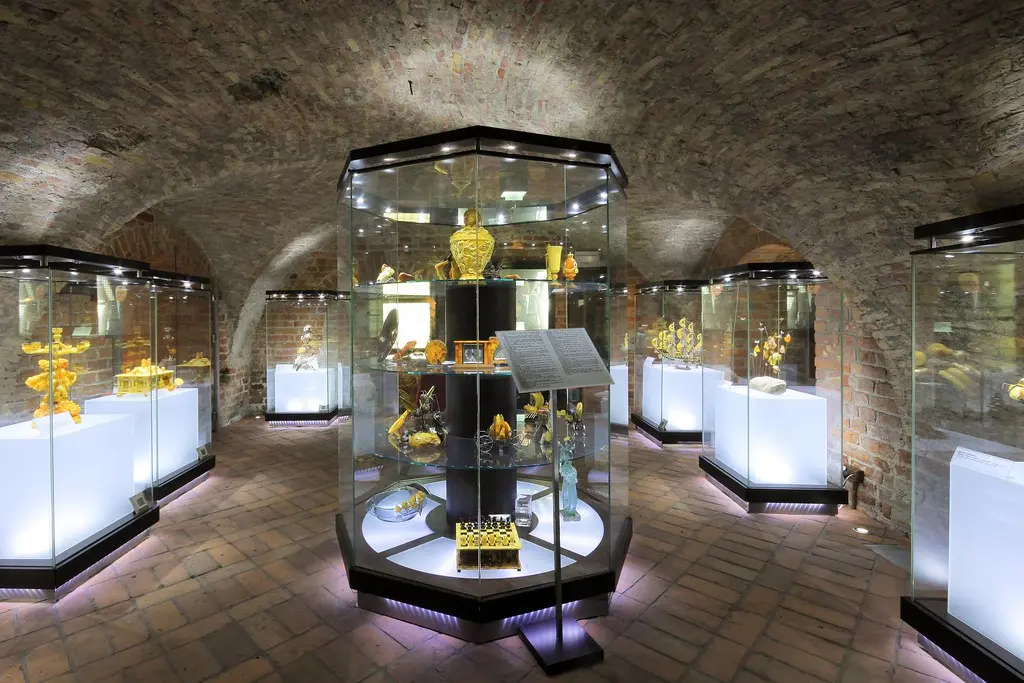
18. Palace of Fine Arts (Palacio de Bellas Artes)
Important Information
- Address: Corner of Av. Máximo Gómez and Independence Avenue, Santo Domingo
- Contact Details: (809) 682‑1325
- Pricing / Admission Fee: Information on public entry not specified; likely accessible during performances or educational events
- Nearby Accommodation: Located in central Santo Domingo—easily reachable from downtown hotels
- Accessibility: Modern neoclassical venue; ADA accommodations not explicitly stated but conjectured typical for such institutions
- Opening & Closing Times: Not indicated (varies by event), but ticket gates typically open 90–120 minutes before events
- Parking: Likely limited on-site; nearby street parking suggested
- Highlights:
- A grand 13,000 m² neoclassical structure inaugurated in 1956, known as the “Freddy Beras Goico Palace of Fine Arts”
- Home to national institutions: Theater of Fine Arts, National Ballets, Symphony Orchestra, and schools for dance, music, drama, and visual arts
Art and elegance come together at the Palace of Fine Arts, one of Santo Domingo’s most beloved cultural landmarks. Inaugurated in 1956, this neoclassical building with its grand columns and domed roof was designed to showcase the richness of Dominican creativity. Located near the heart of the city, it has become the stage for countless plays, ballets, operas, and concerts.
Inside, the main theater seats over 600 guests, offering an intimate yet majestic space where audiences connect closely with performers. The Palace also houses art galleries, rehearsal rooms, and studios, making it a hub for both established artists and emerging talent. Over the years, it has hosted international productions as well as uniquely Dominican performances that highlight local music, dance, and drama.
Beyond its role as a theater, the Palace of Fine Arts is a cultural gathering place. Festivals, art exhibitions, and national celebrations often spill into its halls, giving it an energy that reflects the country’s vibrant spirit. Even if you’re not catching a show, the building itself is worth admiring for its architectural beauty and historical importance.
19. Pantheon of the Fatherland (Panteón de la Patria)
Important Information
- Address: Nass in the Colonial Zone, at Las Damas & Luperón streets
- Contact: Not publicly listed
- Admission & Hours:
- Free entry
- Open Tue–Sun: 9 AM–5 PM; closed Mondays
- Nearby Accommodation: Within walking distance in the heart of the Colonial Zone
- Accessibility: Historic building—some steps may be present; inquire if necessary
- Parking: Limited—walking is recommended
- Highlights:
- Neo-classical mausoleum honoring national heroes like Juan Pablo Duarte
- Known for serene architecture and heritage-driven exhibitions
The Pantheon of the Fatherland is not just a building—it’s a national shrine. Built in the 18th century by the Jesuits, it was originally a church, but today it serves as the resting place for many of the Dominican Republic’s most important heroes. Figures like Juan Pablo Duarte, Francisco del Rosario Sánchez, and Gregorio Luperón—leaders of independence and defenders of the nation—are honored here.
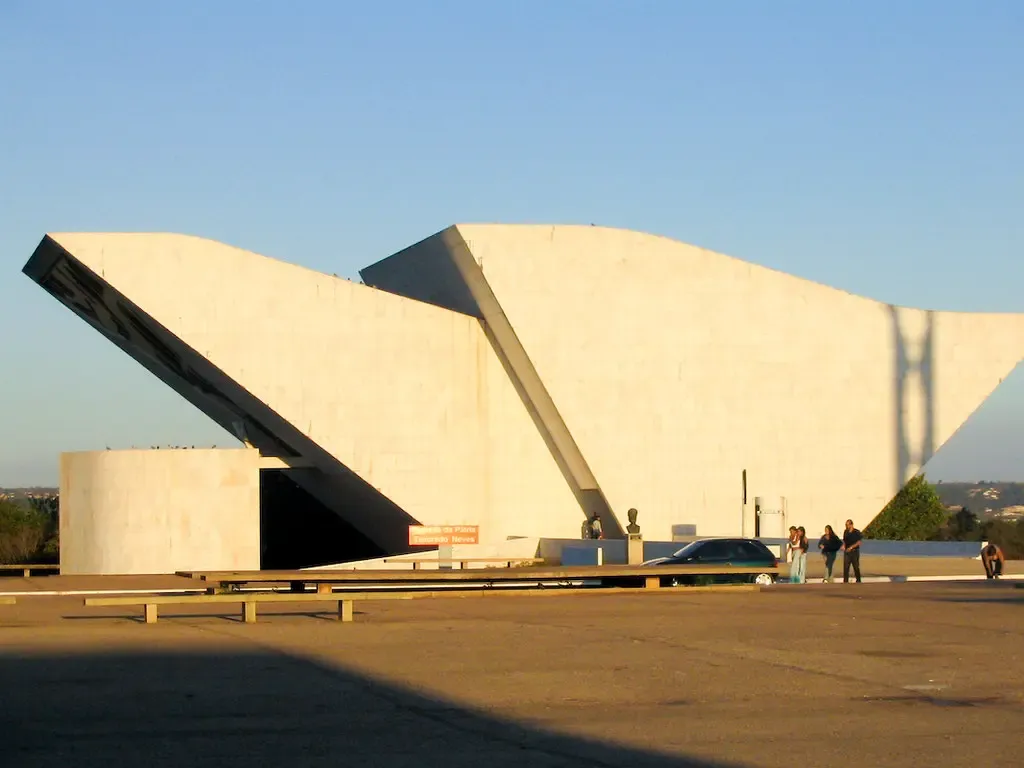
The structure itself is striking. With its baroque façade and solemn interior, the Pantheon inspires both awe and respect. A Dominican flag hangs proudly inside, and a guard of honor keeps watch over the eternal flame that burns for the country’s fallen patriots. The combination of religious architecture and military solemnity gives it a unique atmosphere, reminding visitors that freedom often comes at a heavy price.
20. Mercado Modelo
Important Information
- Address: Avenida Mella, Santo Domingo (Colonial Zone)
- Contact: +1 (809) 750‑0000
- Admission & Hours:
- Free to enter; open daily from 9 AM to 6 PM
- Nearby Accommodation: Accessible by short walk or ride from Colonial Zone lodging
- Accessibility: Indoor market—crowded in parts; navigate with care
- Parking: Nearby paid street parking available
- Highlights:
- Santo Domingo's largest traditional market—350+ stalls
- Offers handmade crafts, amber jewelry, local art, fresh produce, and a rich cultural vibe
For a completely different Santo Domingo experience, head to Mercado Modelo, the city’s most famous traditional market. Opened in the 1940s, it quickly became the go-to place for artisans, merchants, and everyday shoppers. Here, history lives not in stone walls but in colors, sounds, and aromas.
Inside the bustling stalls, you’ll find everything from handcrafted jewelry and wooden carvings to vibrant paintings and Dominican cigars. It’s the perfect place to shop for souvenirs while experiencing the energy of local commerce. Vendors are often happy to explain the meaning behind their crafts or share stories about their families’ traditions.
Mercado Modelo is also known for its lively bargaining culture—haggling is part of the fun. Beyond crafts, the market offers traditional medicines, herbs, and even local food stands serving authentic Dominican dishes. In many ways, it reflects the blend of cultures—Taíno, African, and Spanish—that define Dominican identity.
Conclusion
Santo Domingo is a city where history and modern life dance side by side. From Columbus Park and the very first cathedral of the Americas to buzzing markets, seaside boulevards, and world-class theaters, it tells the story of how the New World began—and how it continues to evolve. Every cobblestone street, every fortress wall, and every lively plaza carries echoes of the past, yet the city is anything but stuck in time. It’s alive with music, flavors, and energy that are unmistakably Dominican.
What makes Santo Domingo truly special is its balance: you can spend the morning exploring centuries-old landmarks, the afternoon tasting chocolate or shopping in sleek malls, and the evening watching the sunset along the Malecón. Add in friendly locals, vibrant culture, and natural escapes like Los Tres Ojos, and you have a destination that offers something for everyone.
Planning to visit? Karta offers amazing deals on Santo Domingo vacation rentals.
Interactive Map
Where to Eat in Santo Domingo
| # | Restaurant | Address (General Area) | Contact Info | Signature Dish / Specialty |
|---|---|---|---|---|
| 1 | Morisoñando | Cargo City, Ruta 66 (near Las Américas Airport), Santo Domingo | — | Modern Dominican fare—deep-fried cassava balls, chivo liniero (braised goat curry) |
| 2 | Ajuala | Calle Andrés Julio Aybar 13, Piantini, Santo Domingo | — | Venezuelan-influenced: casabe baked on a burén with herby sauce, extensive wine list |
| 3 | El Gallego | Santo Domingo (general) | — | Spanish-Dominican fusion—fideuà (noodle paella), cod fritters, beet-and-shrimp tartlets |
| 4 | Casa Brava | Piantini, Santo Domingo | — | Spanish cuisine—traditional and modern tapas, warmly stylish ambiance |
| 5 | Samurai | Santo Domingo (Piantini area) | — | Premium Japanese restaurant—traditional sushi and sashimi since 1990 |
| 6 | Maraca | Santo Domingo (general) | — | Creative modern cuisine—wagyu beef tartare, steak tartar reinterpretations |
How to Get to Santo Domingo
Santo Domingo, the capital of the Dominican Republic, is located on the southern coast of the island of Hispaniola. As the largest city in the Caribbean, it is a major hub that is well-connected by air, road, and sea.
By Air
The most common way to reach Santo Domingo is by flying.
- Las Américas International Airport (SDQ) is the city’s main airport, about 30 minutes east of downtown. It receives direct flights from major U.S. cities (Miami, New York, Atlanta), Europe (Madrid, Paris), and Latin America.
- La Isabela International Airport (JBQ), located closer to the city center, primarily serves domestic routes and some flights to nearby Caribbean destinations.
Taxis, ride-shares, and shuttle services are readily available at both airports for transfers into the city.
By Car
For those already in the Dominican Republic:
- From Punta Cana: About 2.5–3 hours (120 miles) via Autopista del Coral and Autopista del Este.
- From Santiago de los Caballeros: Roughly 2 hours (96 miles) via Autopista Duarte.
- From Puerto Plata: Around 3.5 hours via Autopista Duarte.
Car rentals are widely available, though traffic in Santo Domingo can be heavy.
By Bus
Several reputable intercity bus companies connect Santo Domingo to other parts of the country:
- Caribe Tours and Metro Bus offer frequent, comfortable service between Santo Domingo, Santiago, Puerto Plata, Sosúa, and other destinations.
- Buses generally terminate at large terminals in the city, from where taxis and ride-shares are accessible.
By Sea
Santo Domingo is also a cruise port, with ships docking at the Sans Souci Cruise Terminal near the Colonial Zone. Ferries also connect Santo Domingo with Puerto Rico via the Ferries del Caribe service.
Local Transportation
Once in Santo Domingo, visitors can use taxis, ride-hailing apps like Uber and InDriver, or the city’s Metro system, which is clean and affordable. For convenience and safety, many tourists prefer organized taxis or private drivers over public buses within the city.
FAQs
1. What are the must-visit historical sites in Santo Domingo
The Colonial Zone is key, home to landmarks like the Alcázar de Colón, Catedral Primada de América, and Fortaleza Ozama.
2. Is Santo Domingo safe for tourists?
It's generally safe, especially in tourist-frequented areas by day, though it’s wise to be cautious, especially at night.
3. What is the best time of year to visit Santo Domingo?
Visiting from November to March is ideal, as you’ll avoid the rainy season and enjoy cooler weather.
4. What local dishes should I try in Santo Domingo?
Sample Sancocho, a rich stew, Mangu, a traditional breakfast dish, and La Bandera, a typical Dominican lunch.
5. How can I get around Santo Domingo?
The city's Metro is efficient for major spots, with buses, taxis, and ride-sharing apps like Uber also available.
6. What are the best shopping areas in Santo Domingo?
Explore modern malls like Ágora Mall and Blue Mall, and don’t miss the Mercado Modelo for local crafts.
7. Are there any beaches near Santo Domingo?
For beach trips, head to nearby Boca Chica or Juan Dolio, both about 40 minutes away and perfect for a day trip.


